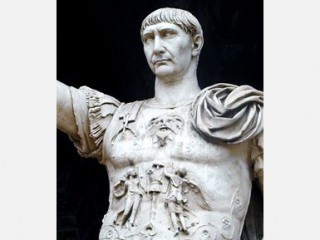
Trajan biography
Date of birth : -
Date of death : -
Birthplace : Rome, Italy
Nationality : Roman
Category : Historian personalities
Last modified : 2010-09-09
Credited as : Roman Emperor, commander of armies on the Rhine, conquered Dacia (now Romania)
5 votes so far
Sidelights
The Roman emperor Trajan (ca. 53-117), or Marcus Ulpius Trajanus, was the first non-Italian emperor. He expanded Rome's territory to its farthest limits, and his designation as optimus princeps, "the best of princes," attests to his reputation.
When Nerva succeeded the murdered Domitian in 96, it was by no means certain that the armies would accept a nice old unknown emperor. The danger from ambitious generals was so real that Nerva adopted Trajan, the commander of the nearest armies (on the Rhine), and made him successor even though he was a native of Italica, a Romanized town of Spain. Henceforth non-Italian lineage was no bar to even the highest position in the empire. The two most important aspects of Trajan's reign were his forward policy on the frontiers and his administrative and building activities, particularly with regard to Italy.
Wars and Conquests
A bit of glory is a source of strength to a new regime, and Trajan seems to have decided to correct Domitian's policy of "weakness" toward the Dacians. The result was two Dacian Wars (101-102 and 105-106), the first apparently sought by Rome, the second clearly a Dacian try for revenge. After the first war Dacia was humbled; after the second it was annexed.
Trajan doubtless recognized the economic value of Dacia (roughly, modern Romania), but he must also have seen the wisdom of advancing a wedge of Roman territory between Rome's possible barbarian enemies, the Germans to the west and the Sarmatians to the east. Dacia in time became thoroughly Latinized, and the Romanians today speak a romance language. Also in 106 the client king of the Nabateans died, and Trajan ordered his territory--approximately modern Sinai, the Negeb, and Jordan--annexed as the province of Arabia.
Parthia, embracing essentially modern Iraq and Iran, was the only major power Rome faced, and the two were constantly at odds as to who should control Armenia, which was strategically important to both. When the question boiled up again, Trajan decided to annex Armenia, which he did (114) with little fighting. Armenia could hardly be held, however, if the Parthians could attack it from Mesopotamia, and in 115 Trajan occupied northern Mesopotamia. In 116 he continued south, took the Parthian capital, and advanced to the Persian Gulf.
Trajan organized his new conquest into provinces, but revolts broke out behind him everywhere. Even within the empire the Jews erupted in a bitter revolt, massacring the Gentiles where they could and being massacred in return. Trajan intended to restore order and resume the war, but he died suddenly (117), and his successor, Hadrian, made peace with Parthia and abandoned the Eastern provinces except Arabia.
Administration and Public Works
Though Trajan's public works were widespread throughout the empire, the most important were in Italy: roads, especially the Via Traiana in the south; large improvements to Claudius's artificial harbor at Ostia; and particularly the immense forum in Rome, surrounded by halls, libraries, and shops and centering on the most famous of all Trajan's works, the great column commemorating his Dacian victories.
Trajan's administrative measures were chiefly designed to preserve the prosperity of Italy. He extended Nerva's scheme of alimenta, low-cost state loans to farmers, whose repayment went to the local communities for the support of poor children. Since the finances of some of the towns were becoming chaotic, he appointed temporary imperial officials, curatores, to control the town budgets. Like the alimenta, this system also spread, and the temporary officials tended to become permanent. Trajan even extended the practice to whole provinces, and his correspondence with his appointee Pliny the Younger shows how petty were the matters which might be referred to the central authority.
The ancients never revised their opinion that Trajan was the best of the emperors, and his reign did inaugurate almost a century in which nearly all elements of the empire worked in harmony, but modern historians have some reservations. Both in money and in manpower his wars overstrained Rome's resources, and his moving the imperial government into local administration started the trend to that overlarge, overworked bureaucracy whose cost (bureaucrats must be paid) and cumbersomeness ultimately contributed to the collapse of the empire.
















